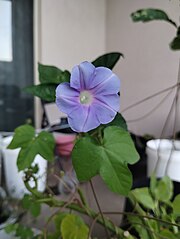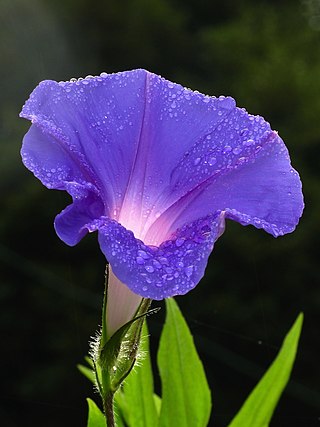
Morning glory is the common name for over 1,000 species of flowering plants in the family Convolvulaceae, whose current taxonomy and systematics are in flux. Morning glory species belong to many genera, some of which are:

Lagerstroemia, commonly known as crape myrtle, is a genus of around 50 species of deciduous and evergreen trees and shrubs native to the Indian subcontinent, southeast Asia, northern Australia, and other parts of Oceania, cultivated in warmer climates around the world. It is a member of the family Lythraceae, which is also known as the loosestrife family. These flowering trees are beautifully colored and are often planted both privately and commercially as ornamentals.

Ipomoea is the largest genus in the plant family Convolvulaceae, with over 600 species. It is a large and diverse group, with common names including morning glory, water convolvulus or water spinach, sweet potato, bindweed, moonflower, etc. The genus occurs throughout the tropical and subtropical regions of the world, and comprises annual and perennial herbaceous plants, lianas, shrubs, and small trees; most of the species are twining climbing plants.
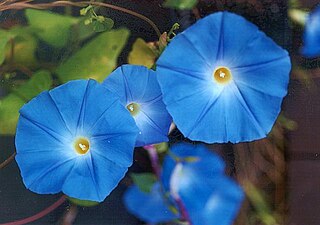
Ipomoea tricolor, the Mexican morning glory or just morning glory, is a species of flowering plant in the family Convolvulaceae, native to the tropics of the Americas, and widely cultivated and naturalised elsewhere.

Ipomoea aquatica, widely known as water spinach, is a semi-aquatic, tropical plant grown as a vegetable for its tender shoots. I. aquatica is generally believed to have been first domesticated in Southeast Asia. It is widely cultivated in Southeast Asia, East Asia, and South Asia. It grows abundantly near waterways and requires little to no care.

Ipomoea alba, known in English as tropical white morning glory, moonflower or moonvine, is a species of night-blooming morning glory, native to tropical and subtropical regions of North and South America, from Argentina to northern Mexico, Arizona, Florida and the West Indies. Though formerly classified as genus Calonyction, species aculeatum, it is now properly assigned to genus Ipomoea, subgenus Quamoclit, section Calonyction.

Ipomoea purpurea, the common morning-glory, tall morning-glory, or purple morning glory, is a species in the genus Ipomoea, native to Mexico and Central America.

Ipomoea pes-caprae, also known as bayhops, bay-hops, beach morning glory, railroad vine, or goat's foot, is a common pantropical creeping vine belonging to the family Convolvulaceae. It grows on the upper parts of beaches and endures salted air. It is one of the most common and most widely distributed salt tolerant plants and provides one of the best known examples of oceanic dispersal. Its seeds float and are unaffected by salt water.

Ipomoea cairica is a vining, herbaceous, perennial plant with palmate leaves and large, showy white to lavender flowers. A species of morning glory, it has many common names, including mile-a-minute vine, Messina creeper, Cairo morning glory, coast morning glory and railroad creeper. The species name cairica translates to "from Cairo", the city where this species was first collected.

Vinca major, with the common names bigleaf periwinkle, large periwinkle, greater periwinkle and blue periwinkle, is a species of flowering plant in the family Apocynaceae, native to the western Mediterranean. Growing to 25 cm (10 in) tall and spreading indefinitely, it is an evergreen perennial, frequently used in cultivation as groundcover.

Ipomoea indica is a species of flowering plant in the family Convolvulaceae, known by several common names, including blue morning glory, oceanblue morning glory, koali awa, and blue dawn flower. It bears heart-shaped or three-lobed leaves and purple or blue funnel-shaped flowers 6–8 cm (2–3 in) in diameter, from spring to autumn. The flowers produced by the plant are hermaphroditic. This plant has gained the Royal Horticultural Society's Award of Garden Merit.
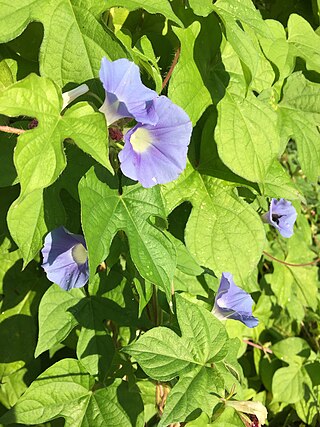
Ipomoea hederacea, the ivy-leaved morning glory or Kaladana, is a flowering plant in the bindweed family. The species is native to tropical parts of the Americas, and has more recently been introduced to North America. It now occurs there from Arizona to Florida and north to Ontario and North Dakota. Like most members of the family, it is a climbing vine with alternate leaves on twining stems. The flowers are blue to rose-purple with a white inner throat and emerge in summer and continue until late fall. The leaves are typically three-lobed, but sometimes may be five-lobed or entire. Flowers occur in clusters of one to three and are 2.5–4.5 cm long and wide. The sepals taper to long, recurved tips and measure 12–24 mm long. The species shares some features with the close relative Ipomoea purpurea, and is almost identical in appearance to wild forms of I. nil.

Salvia farinacea, the mealycup sage, or mealy sage, is a herbaceous perennial native to Nuevo León, Mexico and parts of the United States including Texas and Oklahoma. Violet-blue spikes rest on a compact plant of typically narrow salvia-like leaves; however, the shiny leaves are what set this species apart from most other Salvia, which bear velvety-dull leaves.
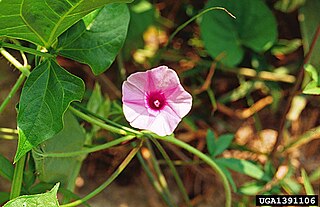
Ipomoea heptaphylla, sometimes known as Wright's morning glory in the United States, is a species of morning glory. It is incorrectly classified as I. wrightii in American publications, but is incorrectly known as I. tenuipes in Africa and India. It is an annual or short-lived perennial vine which climbs using twining stems, and has pink or purple flowers. The leaf shape is somewhat variable, with individuals possessing compound leaves palmately divided into five leaflets, and lanceolate-leaved individuals occurring in neighbouring populations. The name heptaphylla actually means 'seven-leaved'. This plant has a very extensive distribution, from Texas and adjacent states in the southeastern USA to Misiones in northern Argentina, the Greater Antilles of the Caribbean, India, Sri Lanka and East and Southern Africa. Despite its wide distribution it is uncommon throughout its range. The rediscovery of the presence of the species in India after an absence of over half a century was published in 2014. The species appears to favour dry subtropical to tropical habitats.

Ipomoea carnea, the pink morning glory, is a species of morning glory that grows as a bush. This flowering plant has heart-shaped leaves that are a rich green and 6–9 inches (15–23 cm) long. It can be easily grown from seeds. These seeds are toxic and it can be hazardous to cattle; the toxicity is related to the swainsonine produced by its endophytes, and to bioaccumulation of selenium in the leaves but mostly in the seeds. Ingestion of seeds or leaves causes abnormal endocrine functions and gastrointestinal functions, immune system alternation, abnormality in embryogenesis.
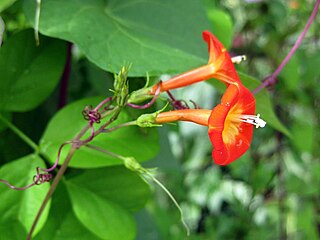
Ipomoea coccinea is a flowering plant in the family Convolvulaceae known by several common names including red morning glory, redstar and (ambiguously) Mexican morning glory.
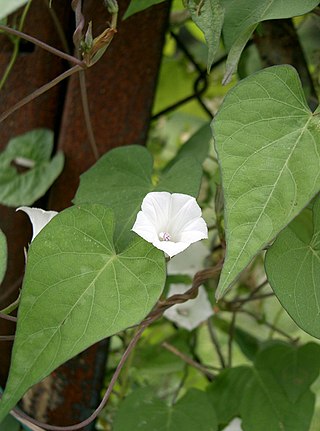
Ipomoea lacunosa, the whitestar, white morning-glory or pitted morning-glory, is a species that belongs to the genus Ipomoea. In this genus most members are commonly referred to as "morning glories". The name for the genus, Ipomoea, has roots in the Greek words ips and homoios, which translates to worm-like. This is a reference to the plant's vine-like growth. Lacunosa comes from a Latin word meaning air spaces, correlating with the venation of the leaves. Ipomoea lacunosa is native to the United States and grows annually. The flowers of this species are usually white and smaller than most other morning glories.
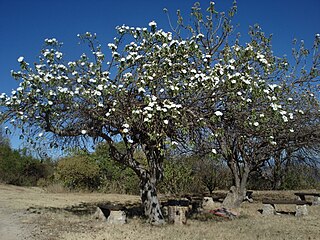
Ipomoea arborescens, the tree morning glory, is a rapidly-growing, semi-succulent flowering tree in the family Convolvulaceae. This tropical plant is mostly found in Mexico, and flowers in late autumn and winter. Its common name in Nahuatl is Cazahuatl or Cazahuate.

Cajanus scarabaeoides is a flowering plant in the genus Cajanus. Of the 32 different species within the genus Cajanus, only one, C. cajan (pigeonpea), is cultivated. Cajanus scarabaeoides is the closest wild relative to C. cajan, and is one of the easiest wild species to cross with pigeonpea cultivars. C. scarabaeoides is found naturally in both temperate and tropical zones around the globe. This species has higher levels of drought tolerance, is found to have greater protein content, and has higher levels of resistance to insect pests compared to cultivated types. These genetic traits can be crossed with C. cajan to improve the crop's productivity. For subsistence farmers, this can reduce economic losses and drastically improve overall crop yield.

Ipomoea oenotherae is a species of plant of the morning glory genus, Ipomoea, in the family Convolvulaceae. It derives its name from the resemblance it bears to plants in the genus Oenothera. Ipomoea oenotherae is a succulent and a cryptophyte.


